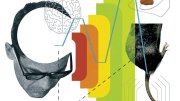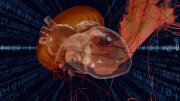What if people could communicate with animals, and even with each other, using only their thoughts?
Such direct brain-to-brain communication became a reality, at least in a very basic sense, at Harvard last year, when a team of researchers led by associate professor of radiology Seung-Schik Yoo developed the first interspecies “brain-to-brain interface” (BBI). The mechanism retrieves a signal from a human’s brain (generated by staring at a flashing light) and transmits it into the motor cortex of a sleeping rat, causing the rodent to move its tail. “We were interested in creating a way for information to be transmitted between two brains without using nerves or muscles,” says Yoo, who found—as reported in the journal PLOS ONE in mid 2013—that a human subject could successfully control tail movement 94 percent of the time. “We were interested in creating a way for information to be transmitted between two brains without using nerves or muscles.”
To achieve this advance, Yoo and his colleagues incorporated discoveries made by others in the rapidly growing field of computer-brain interaction. In recent years, scientists have overcome immense technical challenges to build computers that read and interpret signals directly from the brain. These brain-computer interfaces (BCIs) have been adapted for use in clinical settings—for instance, doctors use them to allow quadriplegic and “locked in” patients to move computer cursors, mechanical arms, and even their own wheelchairs.
Using this research, Yoo and his team built a machine that not only receives signals from the brain using existing BCI technology, but also inserts those same signals into the brain of a separate organism. “The real challenge was figuring out how a computer can somehow control the brain activity in the rat—the computer-brain interface,” he explains. “The difficulty was to create a method that offered a fine level of control without having to perform surgery” to insert electrodes into the brain.
The most common method of noninvasive brain stimulation—transcranial magnetic stimulation—is not accurate enough to stimulate the tiny region of the rat’s brain associated with tail movement, Yoo says. Instead, he and his team relied on a technology that he has been studying since 2007, “focused ultrasound” (FUS), that enables stimulus of specific areas of the brain using focused beams of acoustic energy. One challenge of ultrasound imaging is that the sound waves cannot penetrate bone. But Yoo’s team “found that you can overcome those limitations if you are using low acoustic frequencies.”
In their experiment, the researchers attached an FUS machine, calibrated to activate the specific cortical region associated with tail movement, to a rat’s skull and placed a human volunteer in a BCI machine that reads neural signals using an electroencephalogram. Then they linked the two interfaces together via computer. In order to generate a command to send to the rat’s brain, the human subjects were asked to stare at a flickering light pattern on a computer screen whenever they intended to move the rat’s tail. This elicited a particular pattern of brain waves, which triggered a focused burst of ultrasound connected to the rat’s brain, causing its tail to move.
Despite the success of the experiment, Yoo sees three areas for improvement. First, he’d like to achieve the same results when the rat is awake. Second, the existing device is essentially just an on/off switch controlling the rat’s tail, but future brain-brain interfaces might be used to send more sophisticated messages that would affect the rat’s entire range of motion. And finally, he would like the system to be bidirectional, allowing in a more distant future for two-way communication between humans, perhaps facilitating brain-to-brain messaging across great distances via the Internet. Eventually, these technologies might even be used to promote social understanding and empathy through a technique called “neural coupling,” in which one person’s neural patterns and experiences are transmitted into the brain of another, allowing the recipient to experience the thoughts and mental states of others.
These mind-boggling possibilities, Yoo says, are likely to be questions for future generations. His own experiments are not conducted in order to achieve any practical outcome, he points out. “For me, this is more philosophical than practical,” he says. “It is really just my boyish curiosity.”









